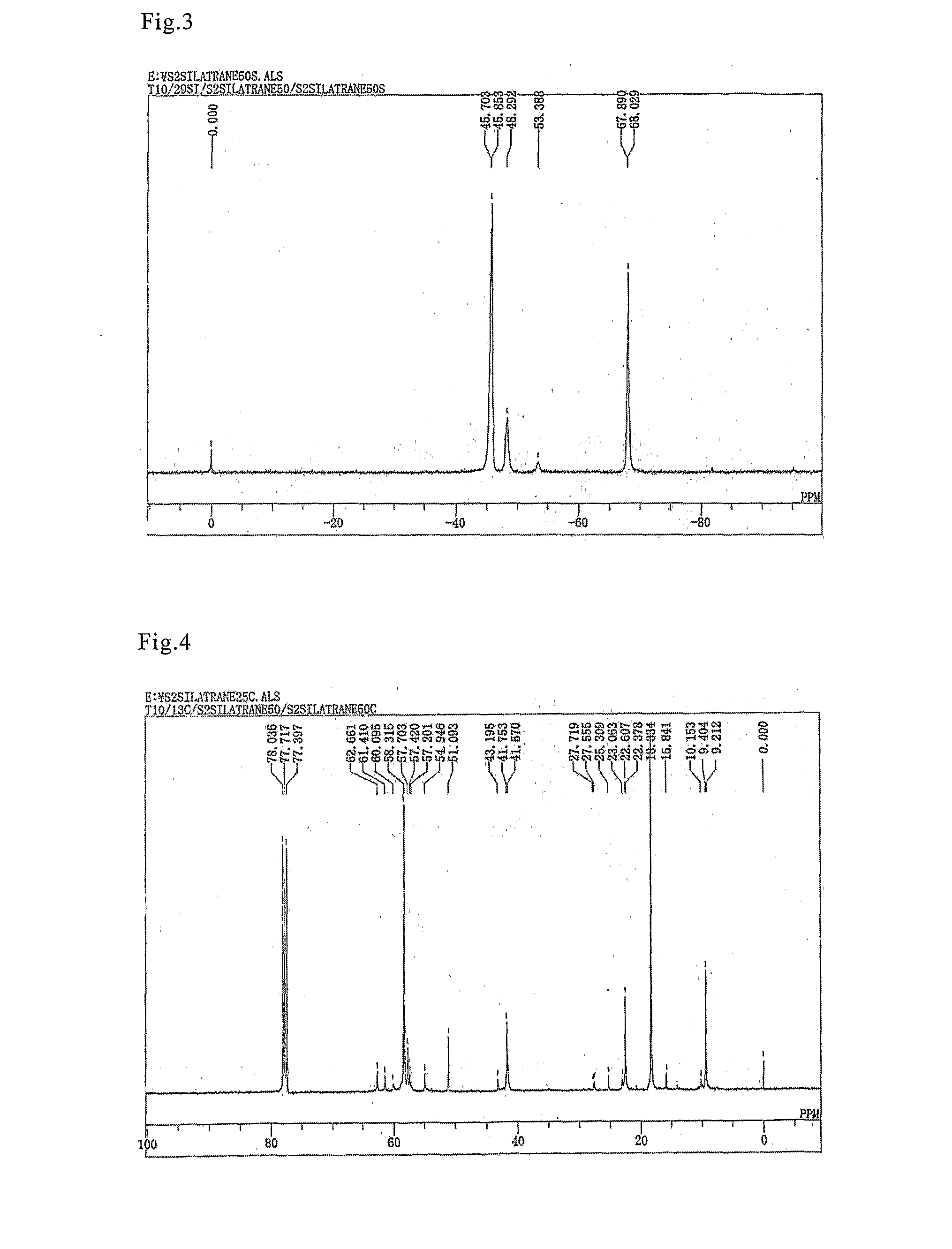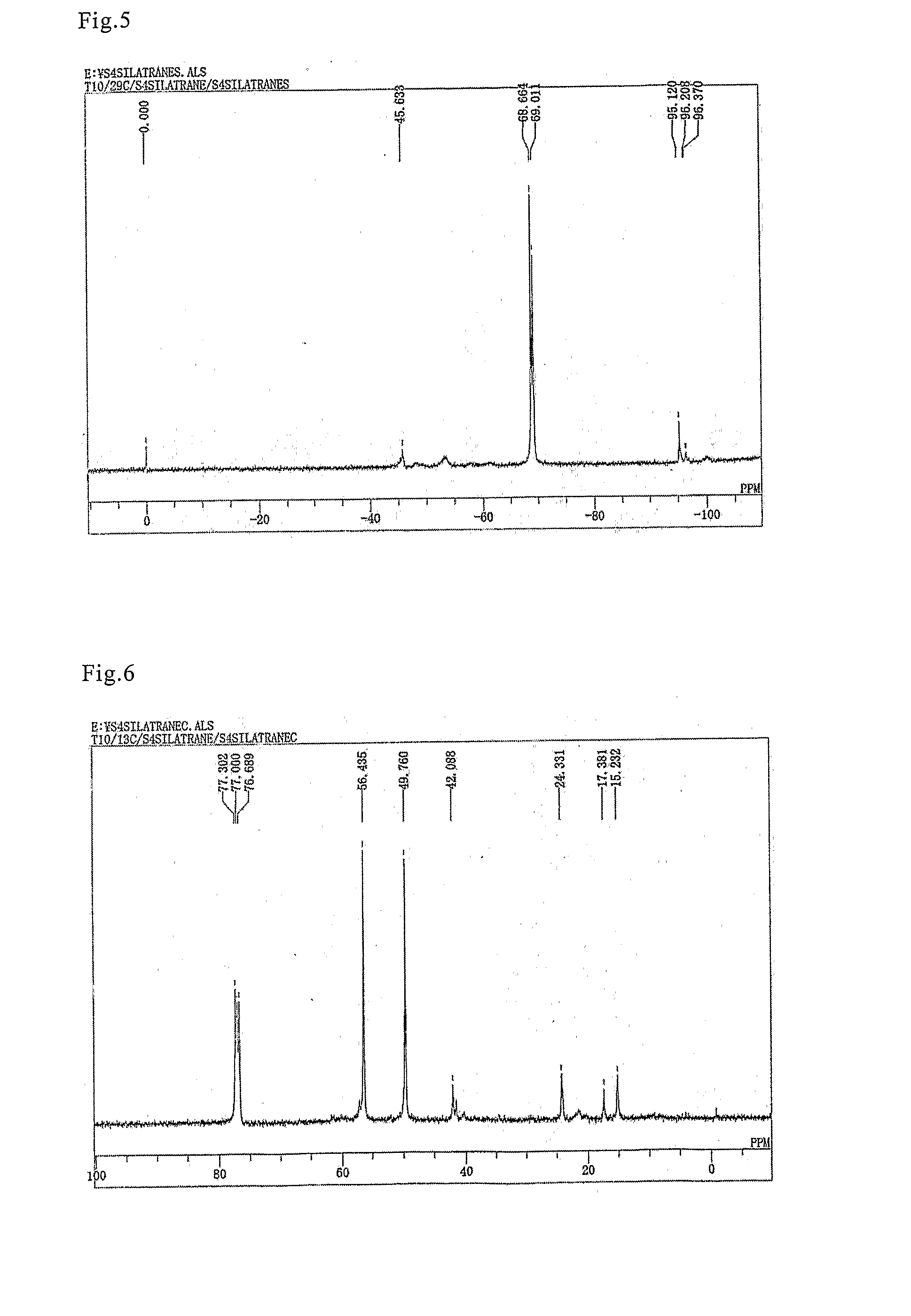Method for Manufacturing A Bis(Silatranylalkyl) Polysulfide, Method for Manufacturing a Mixture of Bis(Silatranylalkyl) Polysulfide etc., A Mixture of Bis(Silatranylalkyl) Polysulfide etc., and Rubber Composition
a technology of alkyl polysulfide and polysulfide, which is applied in the field of manufacturing methods for a bis (silatranylalkyl) polysulfide, can solve the problems of high toxicity, constant wearing of anti-toxic masks, and the dispersion of silica fillers in such substances as natural rubber or synthetic rubber, and achieves high environmental safety and environmental safety.
- Summary
- Abstract
- Description
- Claims
- Application Information
AI Technical Summary
Benefits of technology
Problems solved by technology
Method used
Image
Examples
example 1
[0037]A flask equipped with a stirrer, thermometer, and condenser was filled with 47.5 g (0.1 mole) of bis(triethoxysilylpropyl) disulfide, 29.8 g (0.2 mole) of triethanolamine, and 0.34 g (0.001 mole) of a 20% ethanol solution of sodium ethylate. The mixture was then stirred for 2 hours at 150° C. while the pressure was reduced to 200 mmHg. After 2-hour stirring, the pressure was further reduced, the ethanol generated in the process was removed by distillation, and 50.1 g of the bis(silatranylpropyl) disulfide shown below were obtained with the yield of 99%.
example 2
[0038]A flask equipped with a stirrer, thermometer, and condenser was filled with 47.5 g (0.1 mole) of bis(triethoxysilylpropyl) disulfide, 14.9 g (0.1 mole) of triethanolamine, and 0.34 g (0.001 mole) of a 20% ethanol solution of sodium ethylate. The mixture was then stirred for 2 hours at 150° C. while the pressure was reduced to 200 mmHg. After 2-hour stirring, the pressure was further reduced, the ethanol generated in the process was removed by distillation, and 48.0 g of a mixture of the bis(silatranylpropyl) disulfide, the (silatranylpropyl)(triethoxysilylpropyl) disulfide, and the bis(triethoxysilylpropyl) disulfide shown below were obtained with the yield of 99%.
(In the above formula, silatranyl groups constitute 50 mole % of the sum of silatranyl groups and triethoxysilyl groups.)
example 3
[0039]A flask equipped with a stirrer, thermometer, and condenser was filled with 47.5 g (0.1 mole) of bis(triethoxysilylpropyl) disulfide, 7.5 g (0.05 mole) of triethanolamine, and 0.34 g (0.001 mole) of a 20% ethanol solution of sodium ethylate. The mixture was then stirred for 2 hours at 150° C. while the pressure was reduced to 200 mmHg. After 2-hour stirring, the pressure was further reduced, the ethanol generated in the process was removed by distillation, and 47.8 g of a mixture of the bis(silatranylpropyl) disulfide, the (silatranylpropyl)(triethoxysilylpropyl) disulfide, and the bis(triethoxysilylpropyl) disulfide shown below were obtained with the yield of 99%.
(In the above formula, silatranyl groups constitute 25 mole % of the sum of silatranyl groups and triethoxysilyl groups.)
PUM
| Property | Measurement | Unit |
|---|---|---|
| mole % | aaaaa | aaaaa |
| melting point | aaaaa | aaaaa |
| physical properties | aaaaa | aaaaa |
Abstract
Description
Claims
Application Information
 Login to View More
Login to View More - R&D
- Intellectual Property
- Life Sciences
- Materials
- Tech Scout
- Unparalleled Data Quality
- Higher Quality Content
- 60% Fewer Hallucinations
Browse by: Latest US Patents, China's latest patents, Technical Efficacy Thesaurus, Application Domain, Technology Topic, Popular Technical Reports.
© 2025 PatSnap. All rights reserved.Legal|Privacy policy|Modern Slavery Act Transparency Statement|Sitemap|About US| Contact US: help@patsnap.com



